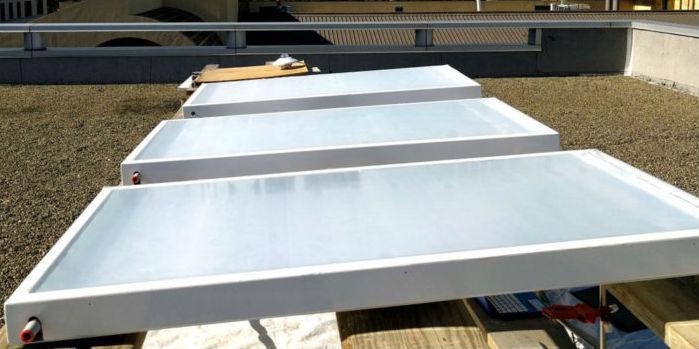 United States. Stanford University is currently testing an innovative cooling technology that uses radiative cooling of the sky. Radiative cooling of the sky is a mechanism that allows cooling to below-ambient temperatures without electricity or water evaporation.
United States. Stanford University is currently testing an innovative cooling technology that uses radiative cooling of the sky. Radiative cooling of the sky is a mechanism that allows cooling to below-ambient temperatures without electricity or water evaporation.
In this approach, heat is passively rejected in outer space exploiting the fact that Earth's atmosphere is partially transparent to mid-infrared thermal radiation.
In a 2014 study, Stanford researchers showed the cooling capabilities of a mirror-like optical surface they were testing on the roof of the Packard Building at Stanford. Other research published in September 2017 showed that a system involving these surfaces can cool flowing water to a temperature lower than that of the surrounding air.
In fact, in the system tested by the researchers, the panels covered on the specialized optical surfaces were able to consistently reduce the water temperature by 3 to 5 ° C below room temperature over a period of 3 days. In a simulation where their panels covered the roof of a commercial office in the warm Las Vegas climate, scientists calculated that the panel-cooled system would save 14.3 MWh of electricity, representing a 21% reduction in the electricity used to cool the building.
"This research builds on our previous work with radiative cooling of the sky, but takes it to the next level. It provides for the first time a high-fidelity technology demonstration of how radiative cooling of the sky can be used to passively cool a fluid and, in doing so, connect it with cooling systems to save electricity," said Aaswath Raman, who is co-lead author of the paper detailing this research, published in Nature Energy on September 4.
Radiative cooling of the sky is a natural process that everyone and everything does, as a result of the moments when molecules release heat. It can be witnessed in the heat coming off a road as it cools down after sunset. This phenomenon is particularly noticeable on a cloudless night because, without clouds, the heat we radiate and everything around us can more easily reach through Earth's atmosphere, to the vast, cold confines of space.
Right now, researchers are measuring the energy saved when the panels are integrated with traditional air conditioning and refrigeration systems in a test facility; Fan, Goldstein and Raman are optimistic that this technology will find wide application in the years to come. The researchers are focused on making their panels easily integrated with standard air conditioning and refrigeration systems and are particularly excited at the prospect of applying their technology to the serious task of cooling data centers.
Source: Stanford University.














